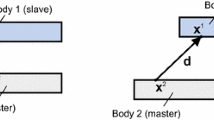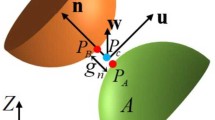Abstract
Modelling discontinuous systems involving large frictional sliding is one of the key requirements for numerical methods in geotechnical engineering. The contact algorithms for most numerical methods in geotechnical engineering is based on the judgement of contact types and the satisfaction of contact conditions by the open–close iteration, in which penalty springs between contacting bodies are added or removed repeatedly. However, the simulations involving large frictional sliding contact are not always convergent, particularly in the cases that contain a large number of contacts. To avoid the judgement of contact types and the open–close iteration, a new contact algorithm, in which the contact force is calculated directly based on the overlapped area of bodies in contact and the contact states, is proposed and implemented in the explicit numerical manifold method (NMM). Stemming from the discretization of Kuhn–Tucker conditions for contact, the equations for calculating contact force are derived and the contributions of contact force to the global iteration equation of explicit NMM are obtained. The new contact algorithm can also be implemented in other numerical methods (FEM, DEM, DDA, etc.) as well. Finally, five numerical examples are investigated to verify the proposed method and illustrate its capability.


















Similar content being viewed by others
Abbreviations
- \({\varvec{\upsigma}}\text{, }\widehat{{\varvec{\upsigma}}}\) :
-
Cauchy stress and its corotational form
- \({\dot{\mathbf{\varepsilon }}},\;\widehat{{{\dot{\mathbf{\varepsilon }}}}}\) :
-
Rate of deformation and its corotational form
- b :
-
Body force vector
- \({\mathbf{u}},{\dot{\mathbf{u}}},{\mathbf{\ddot{u}}}\) :
-
Displacement, velocity and acceleration vectors
- D :
-
Constitutive equation
- R :
-
Rotation matrix
- \({\mathbf{t}}_{\text{c}}^{\left( i \right)}\) :
-
Contact traction between two bodies
- \({\mathbf{p}}_{k}^{\left( i \right)} ,{\mathbf{p}}_{k,j}^{\left( i \right)}\) :
-
Normal contact force acted on the segment \(c_{k}^{\left( i \right)}\) or sub-segment \(c_{k,j}^{\left( i \right)}\)
- \({\mathbf{P}}_{k}^{\left( i \right)} ,{\mathbf{P}}_{k,j}^{\left( i \right)} ,{\mathbf{x}}_{k}^{\left( i \right)} ,{\mathbf{x}}_{k,j}^{\left( i \right)}\) :
-
Equivalent normal point load of \({\mathbf{p}}_{k}^{\left( i \right)} ,{\mathbf{p}}_{k,j}^{\left( i \right)}\) and their point of force application
- \({\mathbf{t}}_{k}^{\left( i \right)} ,{\mathbf{t}}_{k,j}^{\left( i \right)}\) :
-
Tangential contact force acted on the segment \(c_{k}^{\left( i \right)}\) or sub-segment \(c_{k,j}^{\left( i \right)}\)
- \({\mathbf{n}}_{\text{c}}\) :
-
Equivalent normal direction \({\mathbf{n}}_{\text{c}}\) of the overlapped contact area
- M :
-
Mass matrix
- \({\mathbf{f}}_{\text{int}} ,{\mathbf{f}}_{\text{ext}} ,{\mathbf{f}}_{\lambda } ,{\mathbf{f}}_{c}\) :
-
Internal nodal force, external nodal force, boundary constraint nodal force and contact nodal forces
- \(\rho\) :
-
Density of material
- \(g_{\text{N}}\) :
-
Penetration of two contact bodies
- \(p_{N} ,t_{T}\) :
-
Normal and tangential components of \({\mathbf{t}}_{\text{c}}^{\left( i \right)}\)
- \(\alpha_{\text{N}} ,\alpha_{\text{T}}\) :
-
Normal and tangential penalty coefficient
- M I :
-
Mathematical cover (MC) patch I
- P i :
-
Physical cover (PC) patch i
- \(w_{i}\) :
-
Weight function of PC patch Pi
- \(c_{k}^{\left( i \right)}\) :
-
Contact segment k of body i
- \(c_{k,j}^{\left( i \right)}\) :
-
Sub segment j of \(c_{k}^{\left( i \right)}\)
References
An XM, Li LX, Ma GW et al (2011) Prediction of rank deficiency in partition of unity-based methods with plane triangular or quadrilateral meshes. Comput Methods Appl Mech Eng 200(5):665–674
An X, Ning Y, Ma G et al (2014) Modeling progressive failures in rock slopes with non-persistent joints using the numerical manifold method. Int J Numer Anal Meth Geomech 38(7):679–701
Bao HR, Zhao Z (2010) An alternative scheme for the corner-corner contact in the two-dimensional discontinuous deformation analysis. Adv Eng Softw 41(2):206–212
Bao H, Zhao Z, Tian Q (2014) On the Implementation of augmented Lagrangian method in the two-dimensional discontinuous deformation analysis. Int J Numer Anal Meth Geomech 38(6):551–571
Beskos DE (1987) Boundary element methods in dynamic analysis. Appl Mech Rev 40(1):1–23
Beskos DE (1997) Boundary element methods in dynamic analysis: part II (1986–1996). Appl Mech Rev 50(3):149–197
Cai Y, He T, Wang R (2000) Numerical simulation of dynamic process of the Tangshan earthquake by a new method—LDDA/microscopic and macroscopic simulation: towards predictive modelling of the earthquake process. Birkhäuser Basel 157:2083–2104
Chen N, Kemeny J, Jiang QH, Pan ZW (2017) Automatic extraction of blocks from 3D point clouds of fractured rock. Comput Geosci 109:149–161
Cundall P (1971) A computer model for simulating progressive large scale movement in block rock systems. Proc Int Symposium. Fracture, ISRM, Nancy. 11-8, pp 129–136
Doolin DM, Sitar N (2004) Time integration in discontinuous deformation analysis. J Eng Mech 130(3):249–258
Fan H, Zheng H, He S (2016) S-R decomposition based numerical manifold method. Comput Methods Appl Mech Eng 304:452–478
Ghasemzadeh H, Ramezanpour MA, Bodaghpour S (2015) Dynamic high order numerical manifold method based on weighted residual method. Int J Numer Meth Eng 100(8):596–619
Grasselli G, Lisjak A, Mahabadi OK et al (2015) Influence of pre-existing discontinuities and bedding planes on hydraulic fracturing initiation. Eur J Environ Civil Eng 19(5):580–597
He L, Ma GW (2010) Development of 3D numerical manifold method. Int J Comput Methods 7(01):107–129
He J, Liu Q, Wu Z et al (2017) Modelling transient heat conduction of granular materials by numerical manifold method. Eng Anal Bound Elem 86:45–55
Hu M, Wang Y, Rutqvist J (2015) An effective approach for modeling fluid flow in heterogeneous media using numerical manifold method. Int J Numer Meth Fluids 77(8):459–476
Itasca Consulting Group Inc (2013) UDEC (Universal Distinct Element Code). Itasca Consulting Group Inc., Minneapolis
Jiang W, Zheng H (2011) Discontinuous deformation analysis based on variational inequality theory. Int J Comput Methods 8(02):193–208
Jiang QH, Zhou CB (2017) A rigorous solution for the stability of polyhedral rock blocks. Comput Geotech 90:190–201
Jiang QH, Deng SS, Zhou CB et al (2010) Modeling unconfined seepage flow using three-dimensional numerical manifold method. J Hydrodyn 22(4):554–561
Jing L (2003) A review of techniques, advances and outstanding issues in numerical modelling for rock mechanics and rock engineering. Int J Rock Mech Min Sci 40(3):283–353
Lisjak A, Grasselli G (2014) A review of discrete modeling techniques for fracturing processes in discontinuous rock masses. J Rock Mech Geotech Eng 6(4):301–314
Lisjak A, Tatone BSA, Mahabadi OK et al (2016) Hybrid finite–discrete element simulation of the EDZ formation and mechanical sealing process around a microtunnel in opalinus clay. Rock Mech Rock Eng 49(5):1849–1873
Maclaughlin MM (1997) Kinematics and discontinuous deformation analysis of landslide movement. Panamerican Symposium on Landslides
Munjiza A (2004) The combined finite–discrete element method. Wiley, New York
Ning YJ, An XM, Ma GW (2011) Footwall slope stability analysis with the numerical manifold method. Int J Rock Mech Min Sci 48(6):964–975
Perrone N, Kao R (1975) A general finite difference method for arbitrary meshes. Comput Struct 5(1):45–57
Popp A, Gee MW, Wall WA (2010) A finite deformation mortar contact formulation using a primal–dual active set strategy. Int J Numer Meth Eng 79(11):1354–1391
Rougier E, Knight EE, Broome ST et al (2014) Validation of a three-dimensional finite–discrete element method using experimental results of the split Hopkinson pressure bar test. Int J Rock Mech Min Sci 70(9):101–108
Shi GH (1988) Discontinuous deformation analysis: a new numerical model for the statics and dynamics of block systems. Ph.D. thesis, Dept. of Civil Engineering, Univ. of California, Berkeley, CA
Shi GH (1992a) Manifold method of material analysis. In: Transactions of the Ninth Army Conference on Applied Mathematics and Computing, DTIC Document: Minneapolis, pp 51–76
Shi GH (1992b) Modeling rock joints and blocks by manifold method. In: Rock Mechanics Proceedings of the 33rd US Symposium, New Mexico, Santa Fe, pp 639–648
Shi GH (1997) Manifold method of material analysis. Transactions of the 9th Army Conf. on Applied Mathematics and Computing, Rep. No. 92-1, US Army Research Office, Minneapolis, MN, pp 57–76
Shi GH (2015) Contact theory. Sci China Technol Sci 58(9):1450–1496
Tian R, Wen L (2015) Improved XFEM—an extra-doffree, well-conditioning, and interpolating XFEM. Comput Methods Appl Mech Eng 285(3):639–658
Tsesarsky M, Hatzor YH (2006) Tunnel roof deflection in blocky rock masses as a function of joint spacing and friction—a parametric study using discontinuous deformation analysis (DDA). Tunnell Undergr Space Technol Inc Trenchless Technol Res 21(1):29–45
Wei W, Jiang Q (2017) A modified numerical manifold method for simulation of finite deformation problem. Appl Math Model 48:673–887
Wei W, Jiang QH, Peng J (2017) New rock bolt model and numerical implementation in numerical manifold method. Int J Geomech 17(5):E4016004
Wei W, Zhao Q, Jiang Q et al (2018) Three new boundary conditions for the seismic response analysis of geomechanics problems using the numerical manifold method. Int J Rock Mech Min Sci 105:110–122
Wong LNY, Wu Z (2014) Application of the numerical manifold method to model progressive failure in rock slopes. Eng Fract Mech 119(3):1–20
Yan C, Zheng H (2016) Three-dimensional hydromechanical model of hydraulic fracturing with arbitrarily discrete fracture networks using finite–discrete element method. Int J Geomech 17(6):04016133
Yan C, Zheng H, Sun G et al (2016) Combined finite–discrete element method for simulation of hydraulic fracturing. Rock Mech Rock Eng 49(4):1389–1410
Yang Y, Zheng H (2016) Direct approach to treatment of contact in numerical manifold method. Int J Geomech 17(5):E4016012
Zhang HH, Han SY, Fan LF et al (2018) The numerical manifold method for 2D transient heat conduction problems in functionally graded materials. Eng Anal Bound Elem 88:145–155
Zheng H, Jiang W (2009) Discontinuous deformation analysis based on complementary theory. Sci China 52(9):2547–2554
Zheng H, Li X (2015) Mixed linear complementarity formulation of discontinuous deformation analysis. Int J Rock Mech Min Sci 75:23–32
Zheng W, Zhuang X, Tannant DD et al (2014) Unified continuum/discontinuum modeling framework for slope stability assessment. Eng Geol 179:90–101
Zheng H, Zhang P, Du X (2016) Dual form of discontinuous deformation analysis. Comput Methods Appl Mech Eng 305:196–216
Zienkiewicz OC, Taylor RL (2000) The finite element method, 5th edn. Butterworth-Heinemann, Oxford
Acknowledgements
The work reported in this paper has received financial support from National Key R&D Program of China (No. 2018YFC1505005), Fundamental Research Funds for the Central Universities (No. 2042018kf0028), and Natural Science Foundation of Hubei Province (No. 2016CFA083). These supports are gratefully acknowledged.
Author information
Authors and Affiliations
Corresponding author
Additional information
Publisher's Note
Springer Nature remains neutral with regard to jurisdictional claims in published maps and institutional affiliations.
Rights and permissions
About this article
Cite this article
Wei, W., Zhao, Q., Jiang, Q. et al. A New Contact Formulation for Large Frictional Sliding and Its Implement in the Explicit Numerical Manifold Method. Rock Mech Rock Eng 53, 435–451 (2020). https://doi.org/10.1007/s00603-019-01914-5
Received:
Accepted:
Published:
Issue Date:
DOI: https://doi.org/10.1007/s00603-019-01914-5




